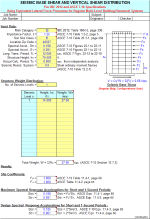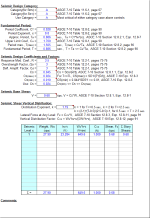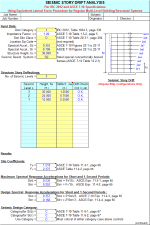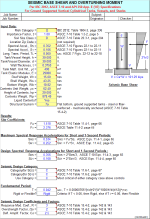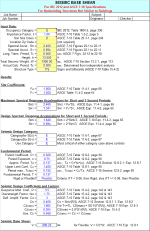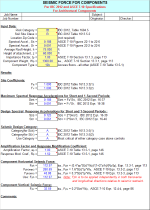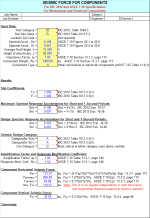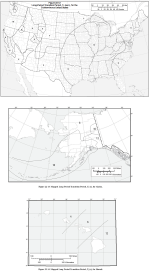ASCE710E
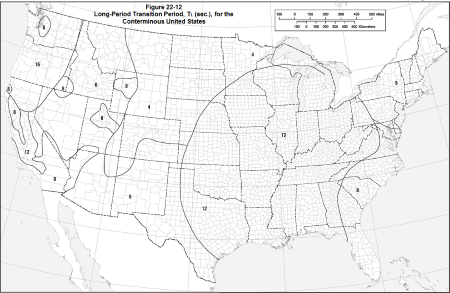
Description
This program is a workbook consisting of (9) worksheets, described as follows:
Worksheet Name - Description
Doc - This documentation sheet
Single-Level Bldg. - Seismic base shear for single-level buildings
Multi-Level Bldg. - Seismic base shear and vertical shear distribution for multi-level buildings
Multi-Level Bldg. (Drift) - Seismic story drift analysis for multi-level buildings
Vert. Tank or Vessel - Seismic base shear and overturning moment for vertical tanks/vessels
Nonbldg. Struct. - Seismic base shear for nonbuilding structures
Arch. Components - Seismic forces for architectural components
M & E Components - Seismic forces for mechanical and electrical components
ASCE 7-05 Maps for TL - ASCE 7-05 Code maps for Long-Period Transition Period
Program Assumptions and Limitations:
1. This program uses the IBC 2012 Code only to determine the Seismic Design Category, while IBC 2012 Code Section 1613.1 permits the Seismic Design Category to be determined by either IBC 2012 or ASCE 7-10. For all practical purposes, beyond determining the Seismic Design Category, the IBC 2012 Code defers to the ASCE 7-10 Code for seismic analysis and design.
3. For buildings, the program assumes the use of the equivalent lateral-force method for analysis, per ASCE 7-10 Section 12.8. This progam does not calculate any non-building structures.
4. The program assumes "regular" buildings and structures, with plan and vertical irregularities not being considered. Refer to ASCE 7-10 Section 12.3 for building configuration, and plan and vertical irregularity criteria.
5. Worksheets for Multi-Level Buildings are applicable for buildings and structures up to 240 feet in height, with up to 15 levels. (Story deflections are to be determined from separate elastic 2D or 3D frame analysis if needed.)
7. Worksheets calculate for "gross" seismic shear force, and do not reflect the use of any load factors. Refer to ASCE 7-10 Section 12.4 for applicable loads factors for LRFD or strength design as well as ASD analysis.
9. This program allows the user to select only site classes "A" through "E", since site class "F" requires site-specific geotechnical investigation and dynamic site response analyses. These same requirements also apply for site class "E", but only when Ss >= 1.25*g and S1 >= 0.5*g.
12. This program automatically selects the appropriate seismic response modifier, "R", once the type of seismic resisting system has been selected/input by the user.
13. This program will automatically alert the user with a "warning message" when any applicable limitations have been exceeded for the particular seismic resisting system selected.
14. This program contains numerous “comment boxes” which contain a wide variety of information including explanations of input or output items, equations used, data tables, etc. (Note: presence of a “comment box” is denoted by a “red triangle” in the upper right-hand corner of a cell. Merely move the mouse pointer to the desired cell to view the contents of that particular "comment box".)
15. In the calculation worksheets, a "hyperlink" is provided to take the user directly to the USGS website at: http://earthquake.usgs.gov/designmaps/us/application.php |
Cross Reference Index between IBC 2009 and ASCE 7-05 Codes
Subject | IBC 2012 | ASCE 7-10 |
Risk Category | Table 1604.5 | See IBC 2012 |
Seismic Importance Factor | Defers to ASCE 7-10 | Table 1.5-2 |
Mapped 0.2 Second Period Spectral Acceleration, Ss | Table 1613.3.1(1) | Figure 22-1 |
Mapped 1.0 Second Period Spectral Acceleration, S1 | Table 1613.3.1(2) | Figure 22-2 |
Site Class | Defers to ASCE 7-10 | Table 20.3-1 |
Acceleration-based Site Coefficient, Fa | Table 1613.3.3(1) | Table 11.4-1 |
Velocity-based Site Coefficient, Fv | Table 1613.3.3(2) | Table 11.4-2 |
Maximum Spectral Response Acceleration, SMS | Eqn. 16-37 | Eqn. 11.4-1 |
Maximum Spectral Response Acceleration, SM1 | Eqn. 16-38 | Eqn. 11.4-2 |
Design Spectral Response Acceleration, SDS | Eqn. 16-39 | Eqn. 11.4-3 |
Design Spectral Response Acceleration, SD1 | Eqn. 16-40 | Eqn. 11.4-4 |
Seismic Design Category Using SDS and Risk Cat. | Defers to ASCE 7-10 | Table 11.6-1 |
Seismic Design Category Using SD1 and Risk Cat. | Defers to ASCE 7-10 | Table 11.6-2 |
Building Configuration | Defers to ASCE 7-10 | Section 12.3.2 |
Permitted Analytical Procedures | Defers to ASCE 7-10 | Table 12.6-1 |
Seismic Load Effects , E and Em | Defers to ASCE 7-10 | Section 12.4 |
Redundancy | Defers to ASCE 7-10 | Section 12.3.4 |
Deflection and Drift Limits | Defers to ASCE 7-10 | Section 12.12 |
Equivalent Lateral Force Procedure | Defers to ASCE 7-10 | Section 12.8 |
Seismic Force Resisting Systems | Defers to ASCE 7-10 | Section 12.2.1 |
Seismic Force Resisting System Coefficients and Factors | Defers to ASCE 7-10 | Table 12.2-1 |
Architectural, Mechanical, and Electrical Components | Defers to ASCE 7-10 | Chapter 13 |
Nonbuilding Structures | Defers to ASCE 7-10 | Chapter 15 |
Note: Per IBC 2012 Section 1613.1, the Seismic Design Category is permitted to be determined by either the IBC 2012 or ASCE 7 Codes. For all practical purposes, beyond determining the Seismic Design Category, the
IBC 2012 Code defers to the ASCE 7 Code for seismic analysis and design.
Note: While this program is intended to accuratly describe the loads/drift limits imposed upon a structure, the final design check is the responsibility of the design engineer. Neither the original composer of this spreadsheet NOR the modifier take any responsibility (either expressed or implied) for the correct output of this program. Once again, the project engineer is to take that responsibility.
Calculation Reference
ASCE 710E
Siesmic Design
Structural Design
Calculation Preview
Full download access to any calculation is available to users with a paid or awarded subscription (XLC Pro).
Subscriptions are free to contributors to the site, alternatively they can be purchased.
Click here for information on subscriptions.

